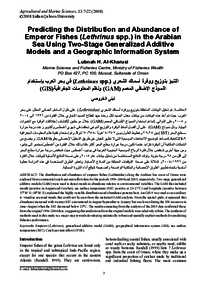Document
Predicting the Distribution and Abundance of Emperor Fishes (Lethrinus spp.) in the Arabian Sea Using Two-Stage Generalized Additive Models and a Geographic Information System.
Publisher
جامعة السلطان قابوس. كلية العلوم الزراعية والبحرية
Gregorian
2008
Language
English
Subject
English abstract
The distribution and abundance of emperor fishes (Lethrinidae) along the Arabian Sea coast of Oman were analysed from commercial catch-per-unit-effort data for the periods 1996–2004 and 2005, respectively. Two-stage generalized additive models (GAM) were used to detect trends in abundance relative to environmental variables. The GAM that included month (positive in August and October), sea surface temperature (SST; positive at 25–27°C) and longitude (positive between 57°50' E-58°50' E) explained the highly variable distribution and abundance patterns best. ArcGIS-9 was used as an auxiliary to visualize seasonal trends that could not be seen from the statistical GAM analysis. From the spatial grids, it appeared that abundance increased with warmer SST encountered in August/September to January but was lower during the SW monsoon in June-August when the SST decreased below 25°C. The results emanating from the analysis of the 2005 data confirmed those from the original 1996–2004 data, suggesting that predictions from the original models were relatively robust. The synthesis of methods used in this study is a major step towards developing statistically robust and spatially explicit methods for predicting fisheries performance.
Member of
ISSN
2410-1079
Resource URL
Citation
Al-Kharusiyah, L. H. (2008). Predicting the Distribution and Abundance of Emperor Fishes (Lethrinus spp.) in the Arabian Sea Using Two-Stage Generalized Additive Models and a Geographic Information System. Agricultural and Marian Sciences Journal, 13 (1),
Arabic abstract
تم تحليل البيانات المتعلقة بتوزيع ووفرة أسماك الشعري ( Lethrinidae ) على طول الساحل العماني المطل على بحر العرب حيث تم أخذ هذه البيانات من بيانات معدل الصيد لكل وحدة جهد لقطاع الصيد التجاري خلال الفترة من 1996 إلى 2004 و 2005 م على التوالي . كما تم استخدام النموذج الإضافي المعمم ( GAM ) خلال مرحلتين لاكتشاف اختلافات الوفرة مع التغيرات البيئية. ودلل نموذج ( GAM ) على أن أفضل أنماط الوفرة و التوزيع النوعي تحققت في شهري أغسطس وأكتوبر وعند درجة حرارة سطح البحر ( SST بين 25 - 27 وخطوط الطول بين 57 50 غربا- 58 50 شرقا. وتم استخدام تقنية نظم المعلومات الجغرافية 9 - ArcGIS كمساعد لتوضيح الاتجاهات الموسمية التي لا تظهر للعيان عن طريق التحليل الإحصائي بطريقة GAM. و يتضح من الشبكات المكانية أن الوفرة تتزايد عندما تكون درجة حرارة سطح البحر أكثر دفئا وذلك خلال الفترة من أغسطس / سبتمبر إلى يناير، ومن جهة أخرى تنخفض خلال فترة الرياح الموسمية الجنوبية الغربية في يونيو - أغسطس حيث تنخفض درجة حرارة سطح البحر إلى أقل من 25 درجة مئوية . وتؤكد النتائج المستخلصة من تحليل بيانات عام 2005 م على صحة النتائج الأصلية للبيانات خلال الفترة من 1996 - 2004 م كدلالة على صحة التوقعات المنبثقة من النماذج الأصلية . وتعتبر الطرق المستخدمة في هذه الدراسة خطوة أساسية باتجاه تطوير الطرق الإحصائية والمكانية الواضحة والصحيحة لتوقع أداء الثروة السمكية.
Category
Journal articles

